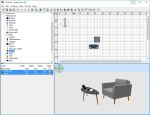- Home
- computer software
- Home Computer Network
Home computer network setup tips
How do you setup home computer network? What are the main tools you need to network home computers? Why should you network your home computers?
In this article, we will see the essential tools you need for home computer network and choosing the best network type that fits with your home physical setting.
Computer network technology enables you to share resources among computers whether you are working at the office or home. Where there are more than two computers, you can connect these computers using network technology.
Home network setup does not require advanced software systems and hardware like large offices and organizations. If you have a small collection of computers at your home, you can inter connect each computer to share data, Game playing, software, devices such as printer and scanner and internet connection. For example, using computer network, you can share a single internet connection to each room of your house or family members.
Steps of home computer network setup
1. Planning
The first step to network home computer is planning. Do a little study by considering your home design and setting. What type of network is best for your home? What are the required devices related with the type of network you have chosen? This is because each network type uses different hardware, so before purchasing any part, first you should decide the type of network and devices you need for the home network.
For example, the wired network type requires a cable to network computers. This dictates that you should run a cable to each room through a ceiling, wall outlet ready for this purpose or wall-to-wall. Make sure your house is good for this kind of network. If not you can move to the other type of network: wireless, which may not require cabling.
2. Deciding your home computer network type
As soon as you finish the planning, you will then have enough information to decide on the type of network you need for your home.
The two major types of computer networks are wired and wireless. These types of network can be installed for home computers; however, there are still other network options suitable for home network purpose, which reduces the cabling and all the stuff related with it.
These home network standards are HomePNA and Home Plug.
HomePNA uses the existing telephone line to connect computers at home. The usage of telephone line as a network media does not interfere with when you make normal calls. Even the latest version of HomePNA enables to add other devices such as TV and Set-Top boxes to the network.
You will find more information about HomePNA here: www.homepna.org
Home Plug is the other home computer network standard, which provides network connections over the existing high-power lines. You need special hardware, called Home Plug Adapter, which enables you to connect a computer with electrical wall socket.
You will find more information about Home Plug here: www.homeplug.org
The disadvantages of both HomePNA and Home Plug home network standards are slower speeds and more expensive comparing to LAN or wireless network types.
The wired Ethernet is the other and the most widely used network type in the world. It is also the easiest and cheapest method to network computers. The wired network uses a cable, network cards and a router to connect the computers at your home, known as LAN (local area network).
Regarding the cable specs, you may use the standard UTP (Unshielded twisted-pair) cable that comes in different type. Using Category 5E and above UTP cables enable you to connect computers up to 1000Mbps (1Gbps) data.
All recent systems have a network card built-in with a computer motherboard. You do not need to buy NIC cards unless the integrated card is malfunctioned.
A Router is a device that enables you to share a single internet connection (dial-up or broadband) to multiple computers that comes to your home. If you cannot afford buying a router, using software you can make one of your computers to act as a router and install home computer network with minimum cost.
Wireless network is the other alternative option for your home network need. The wireless network technology uses radio waves to transfer data among computers. In wireless network, there is no cabling.
In order to install a wireless network, you need a Router (access point), wireless network card for each computer and repeaters. To reduce the interruption due to walls and distance you may need repeaters to strengthen the coverage so that you will not lose the connection when you move your laptop from one room to the other.
Howerver, comparing to wired network, wireless network is slower in speed and less secured.
3. How to secure your home computer network
Whether you have wired or wireless network or the home network standard types, securing your home network is essential.
Depending on the type of network you install, each type has its own security methods. The most popular security methods include firewall, encryption and other protection programs designed for these purpose. In addition, adding extra layer of security to these types of protection will secure your home network further.
Also, look additional features when you buy network devices such as Routers and switches. Most recent Routers include not only switches, firewall features are also built-in, so be sure you purchase a device that supports firewall as well.
Windows operating system also incorporates security features that can be implemented on each computer as well as on the entire network. Using network operating system, you can secure your network by creating users or clients that are authorized and permitted to access the network.
Conclusion
This is an overview of home network. It outlines some basic information for those who want to install a network at their home.
As we have seen, if you follow the procedures, home computer network is easy to install. In addition, you must be familiar with each type of network type, the devices related with each network type and the availability of the installation materials.


